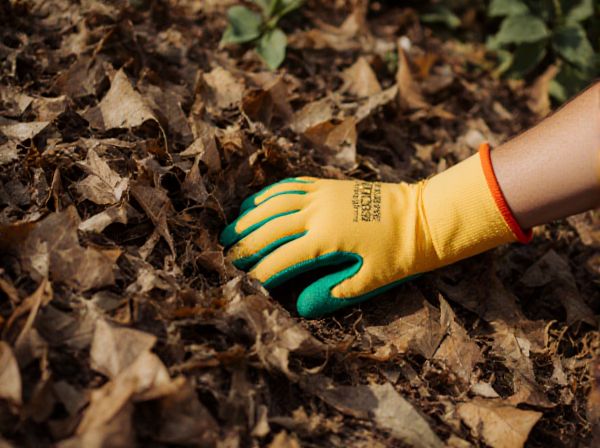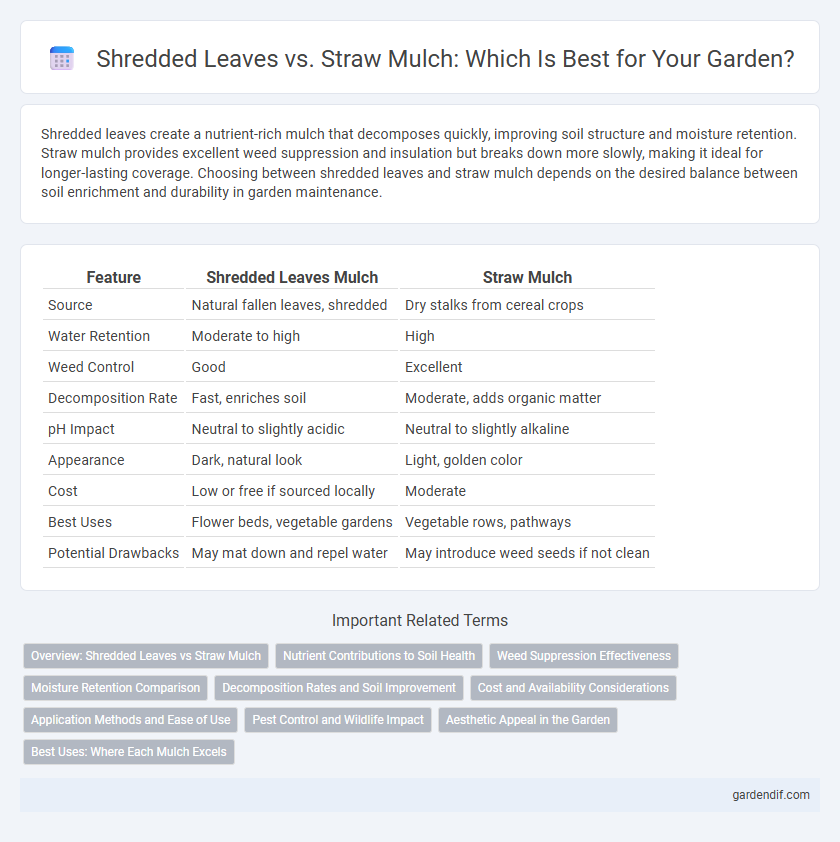
Shredded leaves vs straw mulch Illustration
Shredded leaves create a nutrient-rich mulch that decomposes quickly, improving soil structure and moisture retention. Straw mulch provides excellent weed suppression and insulation but breaks down more slowly, making it ideal for longer-lasting coverage. Choosing between shredded leaves and straw mulch depends on the desired balance between soil enrichment and durability in garden maintenance.
Table of Comparison
| Feature | Shredded Leaves Mulch | Straw Mulch |
|---|---|---|
| Source | Natural fallen leaves, shredded | Dry stalks from cereal crops |
| Water Retention | Moderate to high | High |
| Weed Control | Good | Excellent |
| Decomposition Rate | Fast, enriches soil | Moderate, adds organic matter |
| pH Impact | Neutral to slightly acidic | Neutral to slightly alkaline |
| Appearance | Dark, natural look | Light, golden color |
| Cost | Low or free if sourced locally | Moderate |
| Best Uses | Flower beds, vegetable gardens | Vegetable rows, pathways |
| Potential Drawbacks | May mat down and repel water | May introduce weed seeds if not clean |
Overview: Shredded Leaves vs Straw Mulch
Shredded leaves mulch offers excellent nutrient retention and decomposes quickly, enriching soil organic matter and supporting microbial activity. Straw mulch provides superior weed suppression and moisture retention but decomposes slower, requiring periodic replenishment to maintain soil benefits. Both mulches improve soil health, yet shredded leaves enhance fertility while straw mulch excels in erosion control and maintaining consistent soil temperature.
Nutrient Contributions to Soil Health
Shredded leaves decompose rapidly, releasing essential nutrients like nitrogen, phosphorus, and potassium that enhance soil fertility and microbial activity. Straw mulch, while slower to break down, provides organic matter that improves soil structure and moisture retention but contributes fewer nutrients compared to shredded leaves. Combining both mulches can balance immediate nutrient supply and long-term soil health benefits.
Weed Suppression Effectiveness
Shredded leaves provide superior weed suppression by creating a dense, compact layer that blocks sunlight more effectively than straw mulch, reducing weed seed germination. Straw mulch, while lighter and allowing more airflow, tends to be less effective at preventing weed growth due to its looser structure and higher likelihood of weed seed contamination. Gardeners seeking maximum weed control often prefer shredded leaves for their ability to form a more impenetrable barrier against invasive plants.
Moisture Retention Comparison
Shredded leaves provide superior moisture retention compared to straw mulch due to their finer texture, which creates a denser barrier that reduces water evaporation from the soil surface. Straw mulch, while effective at preventing soil erosion, tends to allow more air circulation and faster drying, leading to less consistent moisture levels. Using shredded leaves can enhance soil hydration for longer periods, benefiting plant health in dry conditions.
Decomposition Rates and Soil Improvement
Shredded leaves decompose faster than straw mulch, enriching soil with organic matter more quickly and boosting microbial activity. Straw mulch decomposes slowly, providing longer-lasting soil cover but contributing fewer immediate nutrients. The accelerated breakdown of shredded leaves enhances soil structure and fertility more effectively, promoting better plant growth and moisture retention.
Cost and Availability Considerations
Shredded leaves are often more cost-effective and readily available in urban or suburban areas during fall, making them an economical choice for mulch. Straw mulch typically has a higher upfront cost and may require purchasing from agricultural suppliers, especially in non-farming regions. Availability of shredded leaves depends on local tree density, while straw mulch relies on seasonal harvest cycles and regional supply chains.
Application Methods and Ease of Use
Shredded leaves mulch easily integrates into garden beds by spreading a thin layer that decomposes quickly, enriching soil with organic matter through natural breakdown. Straw mulch requires a thicker layer to effectively suppress weeds and retain moisture, often needing additional anchoring like landscape fabric or weights to prevent displacement by wind. Both mulches are simple to apply, but shredded leaves offer more effortless incorporation into soil, while straw demands more maintenance to maintain coverage.
Pest Control and Wildlife Impact
Shredded leaves create a dense, natural barrier that deters pests by promoting beneficial insect habitats and enhancing soil moisture retention, reducing the need for chemical pest control. Straw mulch offers less pest-repellent properties but provides shelter for small wildlife, potentially attracting beneficial predators like birds and predatory insects. Choosing shredded leaves supports a balanced ecosystem by minimizing pest populations without disrupting local wildlife, whereas straw mulch may increase habitat complexity but requires monitoring for pest attraction.
Aesthetic Appeal in the Garden
Shredded leaves create a natural, rich texture with deep earthy tones that blend seamlessly into garden beds, enhancing the overall organic aesthetic. Straw mulch offers a lighter, golden-yellow color that brightens garden spaces and provides a rustic charm often preferred in cottage or vegetable gardens. Choosing between shredded leaves and straw mulch depends on the desired visual effect, with leaves promoting a subtle, woodland look and straw delivering a more vibrant, seasonal contrast.
Best Uses: Where Each Mulch Excels
Shredded leaves excel as mulch in flower beds and vegetable gardens by providing rich organic matter that improves soil fertility and moisture retention. Straw mulch is ideal for protecting delicate seedlings and preventing erosion on sloped areas due to its lightweight structure and excellent insulation properties. Both mulches enhance soil health but choosing shredded leaves or straw depends on specific garden needs such as nutrient contribution versus weed suppression and erosion control.
Shredded leaves vs straw mulch Infographic

 gardendif.com
gardendif.com